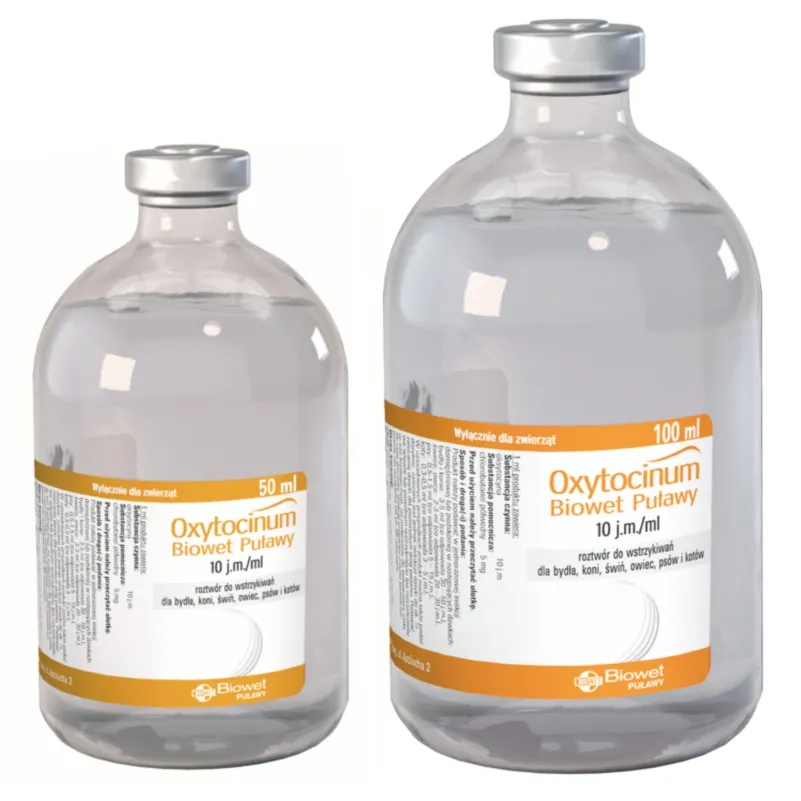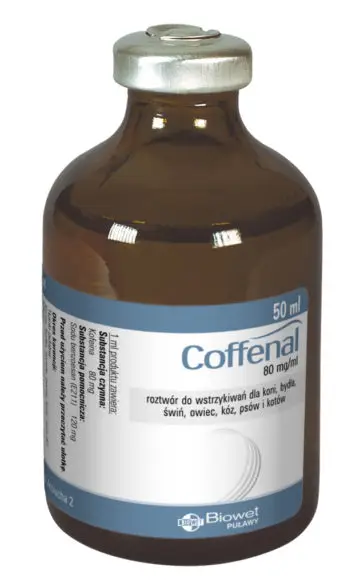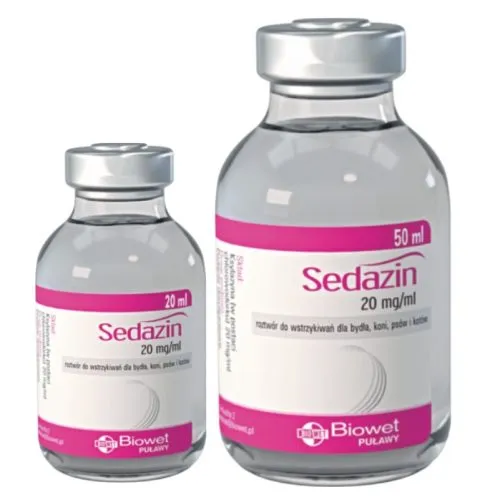Description
Solution of synthetic oxytocin for injection for cattle, horses, swine, sheep, dogs and cats
Active substance and excipient content
1 ml contains:
Active substance:
oxytocin 10 IU
Excipient:
chlorobutanol hemihydrate 5 mg
Therapeutic indications
Stimulation of uterine contractions to induce labour.
Support of involution of the uterus after labour.
Increasing contractility of the myometrium after labour in order to prevent haemorrhage and retained placenta.
Induction of milk letdown in the case of postpartum dysgalactia.
Contraindications
The use of oxytocin is absolutely contraindicated in the following situations:
– obstruction of the reproductive tract (labour with the cervix closed, no full dilation of the cervix, improper position of the foetus/foetuses, etc.),
– Occurence of tetanic contractions
Adverse reactions
The effect of high oxytocin doses depends on the functional condition of the uterus and the position of the foetus. Excessive uterine contractions or tetanic contractions induced by oxytocin may lead to exaggerated intensification of labour, metrorrhexis, damage to the foetus or even deaths of unborn foetuses. Intravenous administration of oxytocin for a longer period of time in a large volume of infusion fluid poor in electrolytes may lead to water intoxication of the female. Early symptoms of the intoxication are sadness and depression. Later a coma, convulsions and death of the female may occur. Oxytocin-induced water intoxication requires administration of drugs increasing diuresis.
Failure to observe intervals between successive oxytocin doses (minimum 30 minutes) may lead to excessive uterine contractions.
An allergic reaction may occur in females of all domestic mammals after administration of natural oxytocin instead of the synthetic one.
Any adverse reactions emerged after administration of the product or any observed symptoms not listed in the leaflet (including symptoms reported in humans following exposure to the product) should be reported to the competent veterinarian, Marketing Authorization Holder or the Office for Registration of Medicinal Products, Medical Devices and Biocidal Products. The report form should be downloaded from https://www.urpl.gov.pl (Department of Veterinary Medicinal Products).
Amount to be administered per species, method and route of administration
The product should be administered in a single intramuscular or subcutaneous injection in the following doses:
cattle and horses: 3-5 ml (which corresponds to 30 – 50 IU),
swine, sheep: 2-3 ml (which corresponds to 20 – 30 IU),
dogs: 0.5-1.5 ml (which corresponds to 5 – 15 IU),
cats: 0.3-0.5 ml (which corresponds to 3 – 5 IU).
In justified cases, the product can also be administered intravenously. However, reduction of the dose to approx. ¼ of the recommended dose for other routes of administration is advised. Administer in an infusion or a slow injection (having diluted it in physiological saline) after the product has been warmed to body temperature.
If necessary, the injection can be repeated, but not sooner than after 30 minutes.
Indications for proper administration
None
Withdrawal period
Edible tissues
Cattle, horses, swine, sheep – zero days.
Milk
Cattle, sheep – zero hours
Dogs, cats – not applicable.
Special precautions for storage
Keep out of the reach and sight of children.
Store at a temperature of 2ºC – 8ºC. Do not freeze. Protect from light.
Do not use the veterinary medicinal product after the expiry date stated on the label.
The durability period after the first opening of the immediate container: 28 days.
Special warnings
Special warnings per target species:
Physiological levels of adrenaline significantly reduce the effect of oxytocin on the myometrium and the mammary gland. Therefore, the treated animals should not be distressed in order to achieve complete efficiency.
Special precautions for use in animals:
Metabolic disorders should be eliminated pharmacologically in animals with hypoglycaemia and hypocalcaemia before administration of oxytocin.
Before administration during labour, complete dilation of the cervix must be confirmed.
Special precautions to be taken by the person administering the veterinary medicinal product to animals:
Caution should be taken to avoid accidental self-injection. In the case of accidental self-injection, immediately seek medical advice and show the package leaflet or the label to the physician. Women, especially those breastfeeding and in advanced pregnancy, should avoid contact with the product since oxytocin may induce contractions of smooth muscles (e.g. uterine muscles).
Pregnancy and lactation:
Oxytocin is used to increase uterine contractions during labour and in lactation in order to empty the mammary gland of milk or inflammatory secretion.
Oxytocin is contraindicated in the last stage of pregnancy due to the risk of miscarriage.
Interactions with other medicinal products and other forms of interaction:
Interaction between oxytocin and insulin and glucagon leads to an increase in the concentration of glucose.
Overdose (symptoms, procedures concerning immediate help and antidotes):
The result of administration of too high a dose of oxytocin may be a long-lasting uterine contraction in concomitance with hypoxia in foetuses or metrorrhexis. Tachycardia may occur.
The effect of oxytocin is removed by beta-adrenomimetics (e.g. clenbuterol, bamethan) and progesterone.
Pharmaceutical incompatibilities:
Oxytocin displays pharmaceutical incompatibility with the following substances: warfarin sodium, fibrinolysin, epinephrine bitartrate and prochlorperazine edisylate.
Special precautions for the disposal of unused veterinary medicinal product or waste materials derived from the use of such products
Medicines should not be disposed of via wastewater or household waste.
Ask your veterinary surgeon how to dispose of medicines no longer required. These measures should help to protect the environment.
Size of the container
Containers: 50 ml, 100 ml
Some container sizes may not be available in the market.
Shelf life
2 years
For animal treatment only.
Subject to medical prescription – prescription drug
Tobe administered under veterinary supervision.
Other information
For more information about this veterinary medicinal product, contact the Marketing Authorization Holder.
2015-01-21 SPC
CPLW 2015.01.21
27.07.2017 r.






